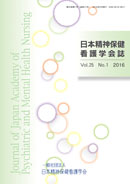Volume 18, Issue 1
Displaying 1-21 of 21 articles from this issue
- |<
- <
- 1
- >
- >|
-
Article type: Cover
2009Volume 18Issue 1 Pages Cover1-
Published: May 31, 2009
Released on J-STAGE: July 01, 2017
Download PDF (18638K) -
Article type: Index
2009Volume 18Issue 1 Pages Toc1-
Published: May 31, 2009
Released on J-STAGE: July 01, 2017
Download PDF (118K) -
Article type: Index
2009Volume 18Issue 1 Pages Toc2-
Published: May 31, 2009
Released on J-STAGE: July 01, 2017
Download PDF (119K) -
Article type: Article
2009Volume 18Issue 1 Pages 1-9
Published: May 31, 2009
Released on J-STAGE: July 01, 2017
Download PDF (1316K) -
Article type: Article
2009Volume 18Issue 1 Pages 10-19
Published: May 31, 2009
Released on J-STAGE: July 01, 2017
Download PDF (1313K) -
Article type: Article
2009Volume 18Issue 1 Pages 20-27
Published: May 31, 2009
Released on J-STAGE: July 01, 2017
Download PDF (1058K) -
Difficulties in Middle-aged Women with Depression Completing Housework After Discharge From HospitalArticle type: Article
2009Volume 18Issue 1 Pages 28-37
Published: May 31, 2009
Released on J-STAGE: July 01, 2017
Download PDF (1283K) -
Article type: Article
2009Volume 18Issue 1 Pages 38-49
Published: May 31, 2009
Released on J-STAGE: July 01, 2017
Download PDF (1487K) -
Article type: Article
2009Volume 18Issue 1 Pages 50-60
Published: May 31, 2009
Released on J-STAGE: July 01, 2017
Download PDF (1549K) -
Article type: Article
2009Volume 18Issue 1 Pages 61-69
Published: May 31, 2009
Released on J-STAGE: July 01, 2017
Download PDF (1175K) -
Article type: Article
2009Volume 18Issue 1 Pages 70-79
Published: May 31, 2009
Released on J-STAGE: July 01, 2017
Download PDF (1365K) -
Article type: Article
2009Volume 18Issue 1 Pages 80-86
Published: May 31, 2009
Released on J-STAGE: July 01, 2017
Download PDF (961K) -
Article type: Article
2009Volume 18Issue 1 Pages 87-93
Published: May 31, 2009
Released on J-STAGE: July 01, 2017
Download PDF (1201K) -
Article type: Article
2009Volume 18Issue 1 Pages 94-103
Published: May 31, 2009
Released on J-STAGE: July 01, 2017
Download PDF (1277K) -
Article type: Article
2009Volume 18Issue 1 Pages 104-113
Published: May 31, 2009
Released on J-STAGE: July 01, 2017
Download PDF (2348K) -
Article type: Article
2009Volume 18Issue 1 Pages 114-120
Published: May 31, 2009
Released on J-STAGE: July 01, 2017
Download PDF (1018K) -
Article type: Article
2009Volume 18Issue 1 Pages 121-127
Published: May 31, 2009
Released on J-STAGE: July 01, 2017
Download PDF (921K) -
Article type: Article
2009Volume 18Issue 1 Pages 128-133
Published: May 31, 2009
Released on J-STAGE: July 01, 2017
Download PDF (798K) -
Article type: Article
2009Volume 18Issue 1 Pages 134-139
Published: May 31, 2009
Released on J-STAGE: July 01, 2017
Download PDF (992K) -
Article type: Article
2009Volume 18Issue 1 Pages 140-146
Published: May 31, 2009
Released on J-STAGE: July 01, 2017
Download PDF (1022K) -
Article type: Cover
2009Volume 18Issue 1 Pages Cover2-
Published: May 31, 2009
Released on J-STAGE: July 01, 2017
Download PDF (416K)
- |<
- <
- 1
- >
- >|
